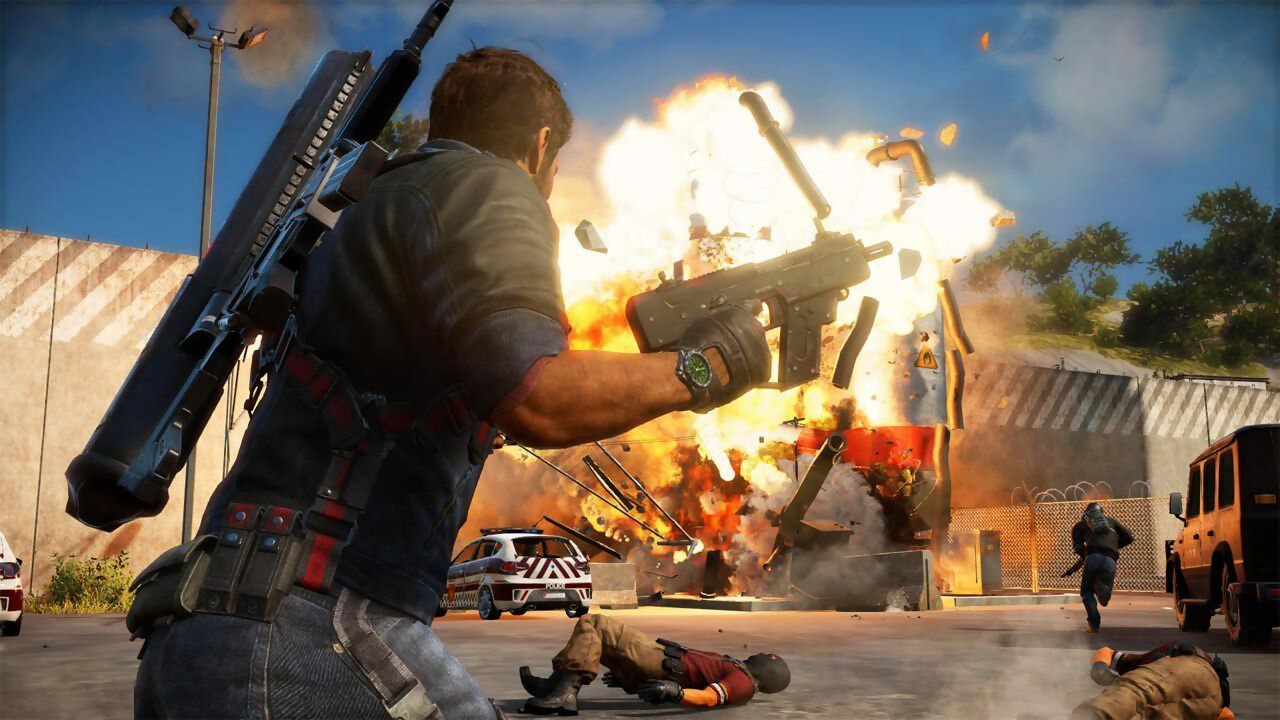
It’s the little details that make a game, sometimes, rather than the big, boundary-pushing concepts. Take the multiplayer shooter, Super Animal Royale: it’s another gun-heavy free-for-all in the mould of PUBG, but it’s the nuances that set it apart. First, Super Animal Royale’s viewed from an old-school, top-down perspective rather than in 3D; second, its horde of up to 64 combatants aren’t buff humanoid soldiers, but cute, cartoon mammals. You’ll see foxes running around with machine guns, bears throwing hand grenades, and cats pointing rifles – it’s like a cross between a Saturday morning TV show and an issue of Guns & Ammo.
Aside from the adorable character design and animation, though, Super Animal Royale’s most eye-catching little detail is its use of line of sight. As your murderous critter runs around the forest map, its view of enemies and collectable items is frequently blocked by other objects. You can approach a tree, entirely unaware that another player’s hiding behind it; you’ll only know for sure if you’re about to be attacked when either you or your opponent breaks cover. It’s a design choice that adds a huge amount of impact to the game’s suspense, as designer Michael Silverwood explains.
“It was really important that you could still have a level of stealth and surprise in close-quarters combat, so that it would feel dangerous as you’re going around,” Silverwood tells us. “Because if you could see everyone everywhere, then a lot of the fights end up happening at the edges of the screen, because you’re able to see each other all the time. They weren’t exciting fights. So we brought (line of sight) in pretty early, and it’s really important to the feel of the game.”
Super Animal Royale’s line of sight mechanic has a subtle visual impact on the game, too: the direction of light changes as you move around the map, which not only affords you a visual clue as to where enemies might be hiding, but also gives the 2D environment a greater sense of volume and depth.
Work began on Super Animal Royale in October 2017, with Silverwood and Pixile Studios co-founder Chris Clogg taking inspiration from other battle royale games they enjoyed, like H1Z1 and PUBG. The idea of having scowling cartoon animals blasting away at each other came about early on because, Silverwood says, he “really liked the juxtaposition” of 64-player violence and pastel-shaded whimsy.
“A lot of prototypes didn’t see the light of day, and then this one – we really liked how it was feeling,” Silverwood says. “So we decided to leave our jobs and go all-in again and try to do another game.”
Before Super Animal Royale, Pixile Studios’ first game was an iOS title called Stratosphere – a 2013 tower defence game that Silverwood and Clogg made while they were still studying computer science in high school. For a few years, day jobs intervened, but the pair never stopped playing around with various game ideas and prototypes – even Silverwood’s move from Vancouver to his current base of San Francisco didn’t stop the two collaborating remotely. Indeed, Super Animal Royale is something of a global operation these days; character artist Amy Deng is based in Los Angeles, while animator Erika Signini is based in the Milan area of Italy. Together, the team have spent the past year or so working on Super Animal Royale across separate time zones.

The line of sight mechanic means you won’t see your rivals until the last second.
Super Animal Royale was built in Unity, while the neat line-of-sight lighting effect mentioned above was achieved by repurposing an existing Unity plugin. “That was really helpful because of the performance,” Silverwood tells us. “It can be a pretty taxing thing to be constantly calculating line of sight and doing the lighting that way, and so Unity definitely helped there, in making all that work.”
Currently in its beta phase at the time of writing, Super Animal Royale has a single last-critter-standing mode to its name, but Pixile has plans for lots more online play options, including a co-op mode and squads. As it stands, though, the game’s already an absorbing and tense little shooter; the range of weapons, from samurai swords to sniper rifles, are satisfying to use, while the game’s sole vehicle – a hamster ball – allows you to zip around the map, gleefully running rival players over.
As in the games that inspired it, there’s a certain thrill to dropping into the battle zone, hunting for weapons, and taking out your rivals in a hail of lead. That you can do this while in the guise of a panda wearing a top hat and monocle merely adds to the charm – plus, you can even do a little victory dance at the end if you want to. Once again, it’s the little details that count.
Maps to the stars
Like a lot of developers, Michael Silverwood and Chris Clogg first got into game design by creating their own maps for games like Team Fortress when they were kids.
“We were making maps for Warcraft 3 and Team Fortress,” Silverwood recalls. “So we were never professionally working on games, but it was a hobby for a really long time. We always wanted to do it.”
As many budding designers know, modding and making maps is a great way to learn the basics of game development. And while it’s early days, Silverwood doesn’t rule out the possibility of adding a map editor to Super Animal Royale.
“It’s definitely something we’d like to do,” Silverwood says. “We already have our own map-making tool that we use to build the map; because it’s so big, we really needed a custom map-maker. Right now, Chris just uses it, but it would be nice, in the future, to polish it up, put a nice UI over everything, and let people make maps.”









